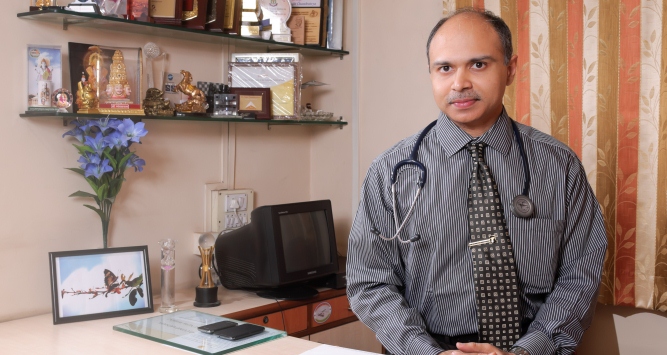Hypertension and Yoga:- By Dr. Sujit Chandratreya
|
Hypertension & Yoga
By Dr. Sujit Chandratreya (MD, DM, DNB, Endocrinologist, Diabetologist)
Introduction : In normal course of blood circulation, the heart received impure blood in its right atrium and sends it to the right ventricle which further sends it to the lungs for purification. The purified blood from the lungs is sent back to the left atrium of the heart which passes it to the left ventricle. Then the blood is distributed to various body organs. Every bit of this blood transport step requires stipulated amount of pressure to carry the blood further. This is called blood pressure. Due to certain physiological disorders of the lumen of the arteries constrict, their volume also reduces. This creates increased pressure inside the arteries which is then referred to as “Hypertension”. Normally the blood pressure during systole (when the left ventricle contracts) should be not more than 120 to 130 mm / Hg. During Diastole (when the left ventricle relaxes) the pressure should be about 80 to 85 mm / Hg. When these values remain elevated for a considerable amount of time, the person is said to be “Hypertensive”. High B. P. may have an hormonal cause among other causes leading to disruption of renin - angiotensin - aldosterone actions, high B. P. may also be as a result of renal disorders. The so called essential hypertension does not show definite correlation to any factor as yet. Hypertension places patients at high risk for target organ damage including, retina, brain, heart, kidneys etc. Observed Effects of Yoga on Blood Pressure 1. Regular practice of Yoga reduces blood pressure to the tune of 10 to 15 mm / Hg (observed facts, good evidence exists to support this observation) Probable Mechanism - achieved by practicing yoga which relieves Hypertension could be as follows. 1. Blood pressure increases by sustained activation of ‘Flight & Fight’ response of the body. Yoga effectively switches off the response and brings adrenaline levels down, thus reducing blood pressure. This postulate can be backed by good amounts of evidences. ----------------------------------------------------- Author : By Dr. Sujit Chandratreya, (MD, DM, DNB, Endocrinologist, Diabetologist), E-Mail : sujit@yogapoint.com Dr. Sujit has excellent academic achievements, he is 1st Rank Gold Medalist for MD (General Medicine) University of Pune, 1st Rank for DM (Endocrinology) with University of Mumbai and all India 1st Rank for DNB (Endocrinology), he has presented many papers in international conferences and has won many awards. He is also a Research Team member with Yoga Vidya Gurukul. ----------------------------------------------------- Mail to : Ahimsa Foundation |
|
